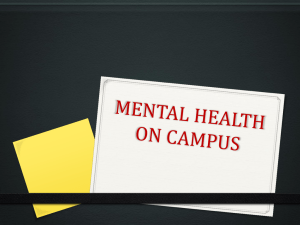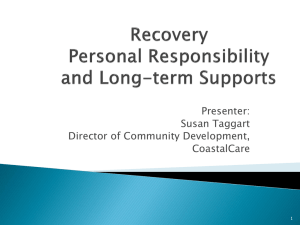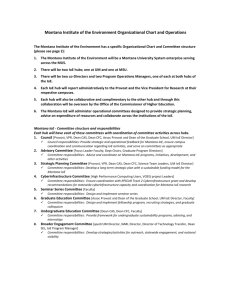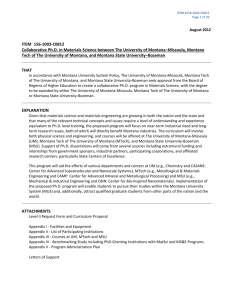Presentation for Mental Health and Research Recovery Proposal
advertisement
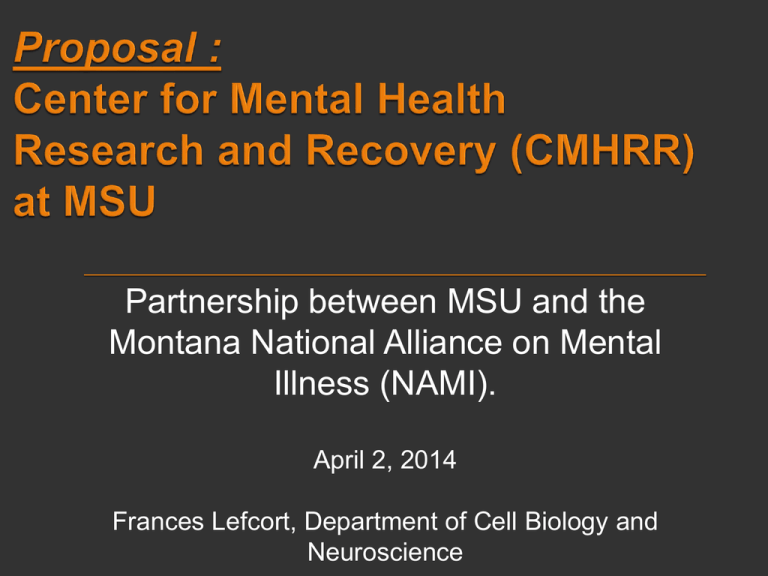
Partnership between MSU and the Montana National Alliance on Mental Illness (NAMI). April 2, 2014 Frances Lefcort, Department of Cell Biology and Neuroscience Summer 2013: Director of Montana NAMI, Matt Kuntz, approached the Department of Cell Biology and Neuroscience (Dr. Charles Gray) with the need to develop novel, neuroscience-based, technologies for diagnosing and treating suicide, PTSD, bipolar disorder and schizophrenia. We discussed this plan with Dean Rae, Provost Potvin and President Cruzado who all supported the idea. December 2013: We discussed this plan Dr. Renee Reijo-Pera, who endorsed the program. She then wrote and submitted a pre-proposal to the OCHE in March 2013 to determine if there were any serious objections to moving forward. Why MSU?: Richest concentration of neuroscientists, engineers, health practitioners, social scientists in the state. History of interdisciplinary collaborations at MSU. MSU already offers a variety of specialized programs, both at the undergraduate and graduate-level, that in combination could fuel a vigorous and preeminent interdisciplinary approach to understanding psychiatric conditions and developing new technologies for their diagnosis and treatment globally and nationally – major scourge. 1 in 4 has mental illness, including substance abuse. Montana has one of the highest suicide rates in the country. •Rural population with social isolation. •Large population of veterans •“Stigma” of mental illness in western states •High rate of substance abuse in MT •Dearth of mental illness diagnosis and treatment services in MT • •2010•15 • 2012: 225-227 suicides per year. attempts per day/5,500 annually 1-2 MSU students commit suicide/year. •Rate of suicide amongst 15-24 year olds has tripled since the 1950s; 2nd most common form of death for college students. - The goal is to establish an interdisciplinary research center with the mission of improving the process of diagnosing and treating serious mental illness through collaborative efforts between neuroscientists, clinicians, engineers, people affected by mental illness, and their families. - Basic, Translational and Clinical research with major emphasis on developing novel technologies for the diagnosis and treatment of mental illness, and on the neural mechanisms underlying serious mental illness and suicide. 1) Insure that Montanans have access within the state to cutting-edge, research-driven techniques for diagnosing and treating mental illness. 2) Focus research efforts on the specific challenges presented when accessing treatment in isolated rural communities with limited treatment providers. 3) Serve as an information hub for the understanding and treatment of psychiatric conditions that lead to suicidal behavior. 4) Create educational opportunities and jobs through the development of a regional “innovation cluster” based upon the revolutions in neuroscience and psychiatric treatment. • Ensure capabilities extend to treatment providers across the state. • NAMI Montana is connected to the Western Montana Mental Health Center, the largest provider of adult mental health services in the state, and AWARE, Inc., the largest provider of children mental health services in the state. • NAMI Montana views the Center at MSU as critical to improving Montana’s mental illness treatment system “from Libby to Baker and everywhere in between.” CMHRR is congruent with the mission of MORH which was established at Montana State University in 1987: "to serve its communities through: (1) collecting and disseminating information within the state, (2) improving recruitment and retention of health professionals into rural areas, (3) providing technical assistance to attract more federal, state, and foundation funding for rural health, and (4) coordinating rural health interests and activities across the state." The CMHRR is focused on Learning and Discovery, the first two goals of the Strategic Plan, while the last two goals, Engagement and Integration, perhaps best encapsulate the vision of this center: to work together as a community of scientists and citizens, using the most creative and innovative science to help solve one of our societies major scourges. There is no space assigned at this time; the program will be launched beginning with FL as the interim director and out of the Department of Cell Biology & Neuroscience. There are natural partnerships across colleges and the interest in housing/participation will be explored across the participants. We hope that a natural home for the program will emerge without need to remodel for the next year or two. Long term space plans will depend on success of fundraising or programmatic input from the faculty involved. • Private, federal and possibly state funding. • We have already submitted 2 Letters of Intent for proposals to the federal government through the PCORI program (Patient Centered Outcome Research Institute). Project 1:Analysis of Cognitive Enhancement Therapy Versus Usual Treatment in Number of Different Facilities and Patient Populations. The question that this research will address is whether the application of Cognitive Enhancement Therapy (CET) throughout the state of Montana mental illness treatment system will significantly improve outcomes that matter to patients including recidivism to inpatient treatment, vocational prospects, symptom reduction, and neuropsychological function. Project 2: A Social Network for Patients, Caregivers, Clinicians, and Researcher. The aim of this study is to create an effective social network system to improve the flow of critical information between patients, caregivers, clinicians, and researchers (Networked Parties). Send your ideas/questions/comments to: lefcort@montana.edu



